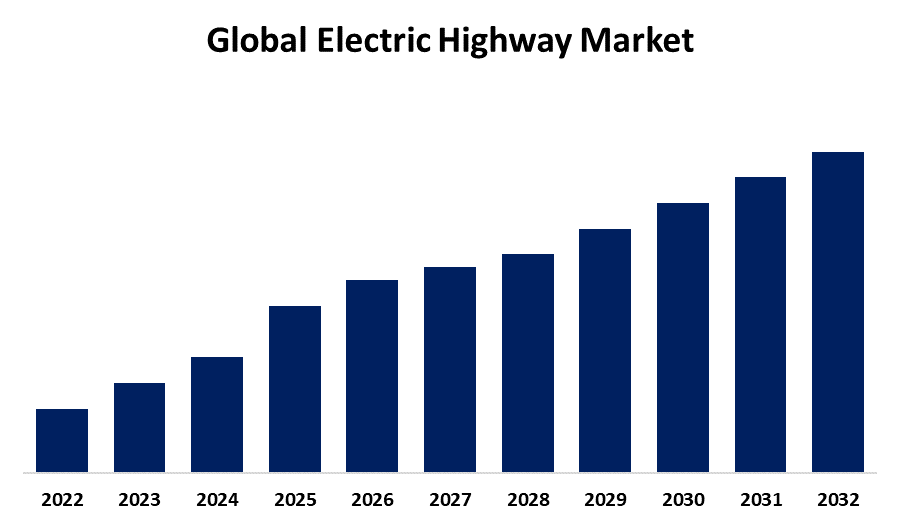Global Electric Highway Market Size, Share, and COVID-19 Impact Analysis, By Technology (Overhead Lines, Rail, and Inductive), By Scale (Local Electrified Roads, Long-distance Electrified Roads), and By Region (North America, Europe, Asia-Pacific, Latin America, Middle East, and Africa), Analysis and Forecast 2022 – 2032
Industry: Automotive & TransportationGlobal Electric Highway Market Insights Forecasts to 2032
- The Market Size is Growing at a CAGR of 12.9% from 2022 to 2032
- The Worldwide Electric Highway Market Size is Expected to Hold a Substantial Share by 2032
- Europe is expected to grow the fastest during the forecast period

Get more details on this report -
The Global Electric Highway Market Size is Anticipated to Hold a Substantial Share by 2032, Growing at a CAGR of 12.9% from 2022 to 2032.
Market Overview
A road with electrical enhancements is called an electric highway. Typically, it refers to a road that provides power to moving cars via overhead power lines or power lines inserted into specially designed grooves in the road. Similar to how railways are serviced, electric highways provide electric traction for automobiles. This is predicated on widely used technology in many nations, including Norway and Sweden. To lessen the effects of the shift and lower air pollution, the idea of the electric highway, or e-highway, has developed. It combines railroad technology with modern highway technology. Reformed hybrid vehicles are powered by overhead connection lines using a dynamic pantograph that can connect and disconnect the overhead cables at speeds of up to 90 Kmph. To support the introduction of new technologies and creative solutions, the government is currently investing in manufacturers and companies that provide highway technology. Industries are implementing cutting-edge Intelligent Transport Systems (ITS) to assist lessen traffic congestion and improve security and safety.
Report Coverage
This research report categorizes the market for the global electric highway market based on various segments and regions forecasts revenue growth and analyzes trends in each submarket. The report analyses the key growth drivers, opportunities, and challenges influencing the global electric highway market. Recent market developments and competitive strategies such as expansion, product launch, and development, partnership, merger, and acquisition have been included to draw the competitive landscape in the market. The report strategically identifies and profiles the key market players and analyses their core competencies in each sub-segment of the global electric highway market.
Global Electric Highway Market Report Coverage
| Report Coverage | Details |
|---|---|
| Base Year: | 2022 |
| Forecast Period: | 2022-2032 |
| Forecast Period CAGR 2022-2032 : | 12.9% |
| Historical Data for: | 2018-2021 |
| No. of Pages: | 200 |
| Tables, Charts & Figures: | 110 |
| Segments covered: | By Technology, By Scale, By Region |
| Companies covered:: | ALE International, ABB Ltd., Honeywell International Inc, AT&T Inc, Cisco Systems Inc, Huawei Technologies Co. Ltd, LG CSN, IBM Corporation, Schneider Electric SE, Siemens AG and Other Key Vendors. |
| Pitfalls & Challenges: | COVID-19 Empact,Challenges, Future, Growth, & Analysis |
Get more details on this report -
Driving Factors
Smaller EV batteries may become possible as a result of electric road networks, which would also reduce range anxiety. According to a study by Chalmers University of Technology in Sweden, electric vehicle (EV) battery costs could be lowered by up to 70% when charging while driving using an electric road system (ERS). An ERS provides electrical energy to charge a car while it is moving using wire loops buried in the pavement or wires suspended above traffic. The battery can be made smaller while still fulfilling customer demands for performance and range because it can be continuously charged while in use. The transportation industry currently uses a lot of fossil fuels, which raises carbon emissions. Electrified roads support the goals of governments and organizations that prioritize carbon reduction by facilitating the widespread use of electric vehicles. The decrease in carbon emissions is consistent with worldwide endeavors to tackle climate change. The implementation of electrified highways as a sustainable transition serves as a prime example of these initiatives.
Restraining Factors
E-Highways are costly as well; setting up the infrastructure for charging them requires spending a lot of money on road construction, electrical line installation, and upkeep. Additionally, as infrastructure is updated, they may cause long-term disruptions to current traffic flow. According to one study, installing a conductive overhead system could take a month, whereas installing a dynamic inductive system could take three weeks for every 100 meters. If ERS construction occurred at the same time as scheduled maintenance, disruption might be reduced, but the speed at which the technology could be implemented would be severely constrained.
Market Segmentation
The Global Electric Highway Market share is classified into technology and scale.
- The overhead lines segment held the major share of the global electric highway market, the segment is expected to sustain the position throughout the forecast period.
Based on the technology, the global electric highway market is divided into overhead lines, rail, and inductive. Among these, the overhead lines segment is expected to hold the largest share of the global electric highway market during the forecast period. The use of overhead technology in trains to provide power has been demonstrated over several years. In certain situations, overhead electrified road systems which normally supply electricity to electric vehicles (EVs) by overhead power lines or catenary systems can be more economical and efficient than alternative electrification techniques. Electric buses and trucks, as well as other heavy-duty electric vehicles, are especially well-suited for overhead electrified roadways. The industry has made significant expenditures to develop dependable E-Highways, which are contributing to the market's expansion.
- The long-distance electrified roads segment is expected to grow at the highest pace in the global Electric Highway market during the forecast period.
Based on the scale, the global electric highway market is divided into local electrified roads and long-distance electrified roads. Among these, the long-distance electrified roads segment is expected to grow at the highest pace in the electric highway market during the forecast period. Large infrastructure investments would be necessary for the widespread use of long-distance electric highways. Resources would need to be allocated by governments, businesses, and other stakeholders to construct and maintain the required infrastructure. Electric vehicles can have a constant power supply from long-distance electrified highways, effectively increasing their range without the need for bulky, cumbersome batteries. For heavy-duty vehicles like trucks and buses, which need greater operating ranges, this is especially crucial. This category is anticipated to have the highest compound annual growth rate in the future.
Regional Segment Analysis of the Global Electric Highway Market
- North America (U.S., Canada, Mexico)
- Europe (Germany, France, U.K., Italy, Spain, Rest of Europe)
- Asia-Pacific (China, Japan, India, Rest of APAC)
- South America (Brazil and the Rest of South America)
- The Middle East and Africa (UAE, South Africa, Rest of MEA)
North America is anticipated to hold the largest share of the global electric highway market over the predicted timeframe.

Get more details on this report -
North America is projected to hold the largest share of the global electric highway market over the predicted years. North America is anticipated to see a rapid innovation in the infrastructure of electric highways. Furthermore, a number of the region's countries have already started experimenting with wirelessly electrified roadways; this is considered an industrial innovation that will emphasize the region's market supremacy. Innovation in electrified road technologies can result from promoting research and development investments in both the public and commercial sectors. Projects to further this technology can be worked on by local universities, research centers, and tech firms.
Europe is expected to grow at the fastest pace in the global electric highway market during the forecast period. This is due to promoting environmentally friendly transportation has been a proactive move for European nations. The use of electric mobility is also being encouraged by several green transportation programs. The demand for electrified road infrastructure and a robust charging system will inevitably arise as more people in the area purchase electric vehicles.
Competitive Analysis:
The report offers the appropriate analysis of the key organizations/companies involved within the global Electric Highway along with a comparative evaluation primarily based on their product offering, business overviews, geographic presence, enterprise strategies, segment market share, and SWOT analysis. The report also provides an elaborative analysis focusing on the current news and developments of the companies, which includes product development, innovations, joint ventures, partnerships, mergers & acquisitions, strategic alliances, and others. This allows for the evaluation of the overall competition within the market.
List of Key Companies
- ALE International
- ABB Ltd.
- Honeywell International Inc
- AT&T Inc
- Cisco Systems Inc
- Huawei Technologies Co. Ltd
- LG CSN
- IBM Corporation
- Schneider Electric SE
- Siemens AG
Key Target Audience
- Market Players
- Investors
- End-users
- Government Authorities
- Consulting And Research Firm
- Venture capitalists
- Value-Added Resellers (VARs)
Recent Developments
- In September 2022, Under the Ease of Doing Business (EoDB) initiative, the National Highway for Electric Vehicles (NHEV) has launched the technological trial run for E-vehicles on the 270-kilometer Delhi Jaipur Expressway.
Market Segment
This study forecasts revenue at global, regional, and country levels from 2020 to 2032. Spherical Insights has segmented the Global Electric Highway Market based on the below-mentioned segments:
Global Electric Highway Market, By Technology
- Overhead Lines
- Rail
- Inductive
Global Electric Highway Market, By Scale
- Local Electrified Roads
- Long-distance Electrified Roads
Global Electric Highway Market, By Region
- North America
- US
- Canada
- Mexico
- Europe
- Germany
- UK
- France
- Italy
- Spain
- Russia
- Rest of Europe
- Asia Pacific
- China
- Japan
- India
- South Korea
- Australia
- Rest of Asia Pacific
- South America
- Brazil
- Argentina
- Rest of South America
- Middle East & Africa
- UAE
- Saudi Arabia
- Qatar
- South Africa
- Rest of the Middle East & Africa
Need help to buy this report?